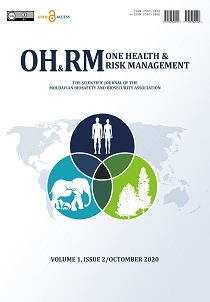Abstract
Introduction. Meningococcal infection (MI) and N. meningitidis carriage are widespread. The global incidence represents a total of 500,000-1,200,000 cases per year, of which 50,000-135,000 are fatal. In European countries the incidence is 0.6-2.0 per 100,000. Infants and young people are more likely to get affected due to different genotypes of meningococci. Thus, MI surveillance is required.
Material and methods. The research purpose was to perform an epidemiological analysis of MI in the Republic of Moldova between 2000 and 2019. In the descriptive retrospective epidemiological study were analysed the total MI incidence of a population of 100,000 people, the number of cases in urban and rural areas, the morbidity rate among 1000 children aged between 0 and 17 years, and patients’ age structure.
Results. A decreased incidence, without cyclicity, was registered over the past 5 years from 2.57 to 0.55-1.01 per 100,000. The number of carriers accounted for 0.48-0.26 per 100,000 between 2000 and 2005, and zero during 2016-2019. MI vaccination is not carried out. The MI incidence in urban and rural areas was the same. In children aged between 0 and 17 years, during 2000 and 2005, MI incidence was 0.05–0.07, compared to 2016–2019 when it constituted 0.02–0.04 per 1000. In children aged between 0 and 2 years these indices were 0.08 per 1000 in 2004, and 0.44 per 1000 in 2018. Thus, the indices were lower among children aged between 3 and 6 years.
Conclusions. Incomplete detection of MI has been noted. Children aged between 0 and 2 years are prone to develop MI, the most vulnerable ones being children aged up to one year. The age structure of patients depends on the intensity of the epidemic process. Hence, it is necessary to improve MI surveillance with genotyping of circulating strains.
|
 Views: 492|
|
Views: 492|
|
